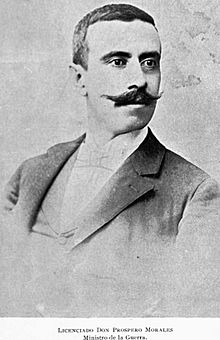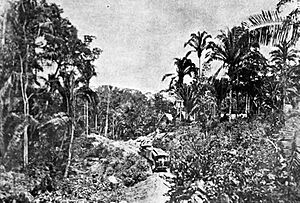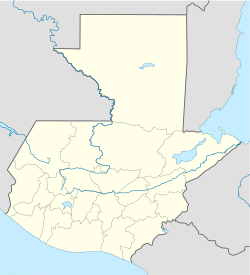Morales, Guatemala facts for kids
Quick facts for kids
Morales
|
|
|---|---|
|
Municipality
|
|

Lawyer and colonel Próspero Morales, after whom the municipality was named. He was secretary of War and Economy for president José María Reina Barrios.
|
|
| Country | |
| Department | Izabal Department |
| Municipality | Morales |
| Creation municipality | 1920-06-24 |
| Area | |
| • Municipality | 1,408 km2 (544 sq mi) |
| Elevation | 75 m (246 ft) |
| Population
(census 2018)
|
|
| • Municipality | 100,361 |
| • Density | 71/km2 (180/sq mi) |
| • Urban | 23,855 |
| Climate | Af |
Morales is a municipality in the Izabal Department of Guatemala. It was created in 1920. The municipality includes the main town of Morales, nine villages, and 56 smaller rural communities. The Cuevas del Silvino National Park is also located close to Morales.
Contents
The Northern Railroad of Guatemala

The Northern Railroad was a very important project for Guatemala. It connected the town of Zacapa, Zacapa to Puerto Barrios. This railway opened on November 22, 1896. It was a big deal for President José María Reina Barrios. He wanted the railroad finished for the Central American Expo in 1897.
The new railway helped open up the northern part of Guatemala. This area was mostly wild and unexplored before. The railroad made it easier to use the natural resources there. It also helped businesses and industries grow.
The full railway line went from Puerto Barrios to Guatemala City. It was about 317 kilometers (197 miles) long. It was built in different sections, which later became train stops. Some of these stops included Tenedores (in Morales), Los Amates, and Gualán.
The United Fruit Company's Influence
In the early 1920s, the United Fruit Company was a very powerful business. They grew a lot of bananas in the Izabal Department. They had received special agreements from the Guatemalan president for many years.
However, in 1920, the company faced a big workers' strike. The government was busy with political problems in Guatemala City. So, they could not help the company stop the strike.
Workers in Morales and Los Amates banana farms joined the strike. More than 250 people in Puerto Barrios also became union members. The strike grew stronger. Because the government did not help, the United Fruit Company supported a new leader. General José María Orellana took power in 1921. He quickly stopped the workers' unions. This brought peace back to the United Fruit Company's operations in Izabal.
The Northern Transversal Strip
In the 1960s, a region called the Franja Transversal del Norte (FTN) became important. This area was known for its cattle, valuable wood, and ancient historical sites. Large companies, like Murphy Pacific Corporation, invested a lot of money there. They wanted to develop the land and use its resources.
The government also helped people move to this area. They gave land to farmers in parts of the FTN that were not settled yet.
In 1964, the National Institute for Agrarian Transformation (INTA) officially defined the FTN. It included the northern parts of several departments. These were Huehuetenango, Quiché, Alta Verapaz, and Izabal. Priests from the Maryknoll order also helped people move and settle in the area.
The Northern Transversal Strip was officially created in 1970. This was during the government of General Carlos Arana Osorio. The goal was to develop farming in the region. The area included many municipalities across several departments, including all of the Izabal Department.
Sports
Morales once had a top-level football (soccer) team called Deportivo Heredia. They played in Guatemala's main football league. However, the team moved to San José, El Petén in 2008. This happened because they did not have enough local support in Morales.
Climate
Morales has a tropical rainforest climate. This type of climate is known for being hot and rainy all year round. The town of Morales is located about 48 meters (157 feet) above sea level.
| Climate data for Morales | |||||||||||||
|---|---|---|---|---|---|---|---|---|---|---|---|---|---|
| Month | Jan | Feb | Mar | Apr | May | Jun | Jul | Aug | Sep | Oct | Nov | Dec | Year |
| Mean daily maximum °C (°F) | 27.5 (81.5) |
29.0 (84.2) |
31.3 (88.3) |
32.7 (90.9) |
33.0 (91.4) |
32.6 (90.7) |
31.4 (88.5) |
31.9 (89.4) |
32.1 (89.8) |
30.7 (87.3) |
28.4 (83.1) |
27.7 (81.9) |
30.7 (87.3) |
| Daily mean °C (°F) | 23.7 (74.7) |
24.4 (75.9) |
26.2 (79.2) |
27.5 (81.5) |
28.2 (82.8) |
28.1 (82.6) |
27.4 (81.3) |
27.6 (81.7) |
27.8 (82.0) |
26.6 (79.9) |
24.8 (76.6) |
24.0 (75.2) |
26.4 (79.5) |
| Mean daily minimum °C (°F) | 19.9 (67.8) |
19.8 (67.6) |
21.1 (70.0) |
22.3 (72.1) |
23.4 (74.1) |
23.7 (74.7) |
23.5 (74.3) |
23.4 (74.1) |
23.5 (74.3) |
22.5 (72.5) |
21.3 (70.3) |
20.3 (68.5) |
22.1 (71.7) |
| Average precipitation mm (inches) | 157 (6.2) |
81 (3.2) |
75 (3.0) |
72 (2.8) |
137 (5.4) |
276 (10.9) |
309 (12.2) |
254 (10.0) |
303 (11.9) |
244 (9.6) |
231 (9.1) |
187 (7.4) |
2,326 (91.7) |
| Source: Climate-Data.org | |||||||||||||
See also
 In Spanish: Morales (Izabal) para niños
In Spanish: Morales (Izabal) para niños


